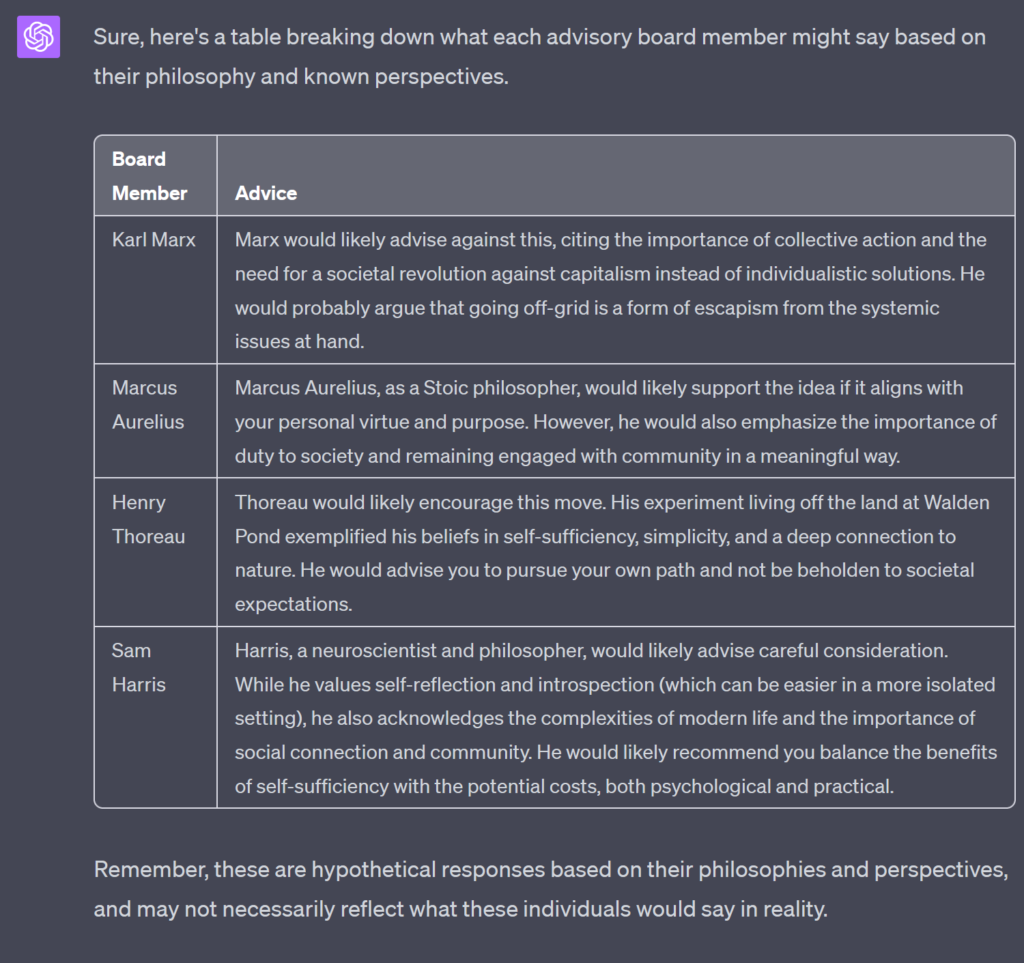
The Boardroom Exercise is simple – when faced with a problem, question or dilemma, you conjure a set of ‘personalities’ as ‘board members’ to advise you. This might sound a little schizophrenic, but hear me out.
Regardless of the problem, there are likely certain members of the board that could offer an interesting insight, but when all of them are combined into your general train of thought, it can be difficult to single out signal from noise. By identifying what voices have a seat at the table, you can single them out, like listening in on a conversation at a party while tuning the rest of the out.
These personalities can be varied: but here’s a few suggestions.
- Positive role models – there are usually at least a few people in your life, whether friends, family, or even long-dead scholars, who you know well enough that you could predict what their advise to you would be. It can be really valuable to tap into the well-meaning advice of someone whose judgment you respect. Of course, if this role model is someone you know, you could even ask them, but in the absence of that, really think about what they’d suggest. Remember the old “What would Jesus do?”, that’s the idea.
- Facets of your own personality – our inner lives can be varied. All of us have aspects of ourselves that we value or resent, whether it’s our ambition, our empathy, or our laziness. They can also be parts of your life you need to pay attention to – the professional, the family man, the artist. This also means…
- Give the devil his due – I usually reserve a seat at the table for a certain character. Who he is from person to person might vary, but I usually just call him the Goblin. The goblin is the board member who generally gives me the advice that the worst part of me wants to hear. If you’re having an interpersonal problem, the goblin might be suggesting you start a fight over it. Or he might just suggest getting drunk or playing video games instead of addressing your problem. Writing down these desires doesn’t mean you intend to act on them, but not only can it be cathartic, it can put your more low-minded desires in stark contrast to the advise of the better angels of your nature. Your shitty self deserves a seat at the table, because he can usually cause more trouble locked in the basement.
Once I’ve settled on a few – usually at least three, I give each his own column on a table and write down all the advice I can think of for each board-member. There will often be overlap, though I think you’ll frequently find that the Goblin is an outlier. Though when everyone, even the goblin, concurs, you’ve got something to really consider.
Using ChatGPT for the Boardroom Exercise
With the rise of sophisticated language models, you have a pretty fascinating tool at your disposal for this exercise. When it comes to populating members of your ‘board’ with public figures who the AI knows about, tools like ChatGPT can actually produce a fairly interesting ‘boardroom exercise’ of its own. This is obviously less useful for contexts where the AI won’t understand the context, like “Should I marry my girlfriend?” or “What would my dad think of this?”, though even then it can sometimes provide some interesting insights. When provided the following prompt, ChatGPT provides this analysis:
”I’m conducting a boardroom exercise, where each figure listed is a member of an advisory board trying to advise me on a problem. Break each of their answers to the problem up into a table.
Should I move into the woods and live off-grid to become self-sufficient? Board members: Karl Marx Marcus Aurelius Henry Thoreau Sam Harris”

Now, this is no substitute for actually thinking about your problem, but it can be particularly useful when you’re conflicted and don’t know where to start. Using tools like AI as a sort of springboard for journal exercises provides feedback that’s often worth considering, even if you sometimes need to be careful of trusting the output. By breaking up the problem into advice by certain characters, you also prime yourself for the reality that the output will be subjective, and you’re less likely to be bamboozled by the sometimes oddly persuasive nonsense ChatGPT can produce.
I hope some of you find this technique useful!

